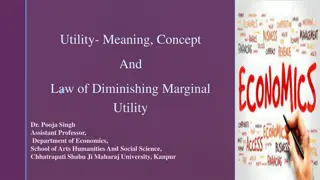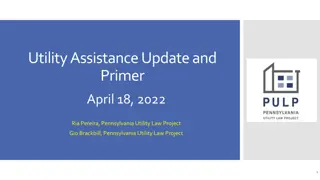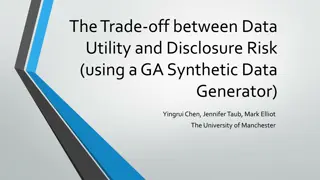FACILITY MANAGEMENT & SAFETY
Facility management and safety are interlinked disciplines crucial for optimizing workflow and ensuring a safe environment in various facilities. This includes managing space, infrastructure, resources, and staff effectively. Specific focus on laboratory facility management involves maintaining qual
4 views • 19 slides
Utility Assistance and Support in Pennsylvania
Gain insights into utility assistance initiatives in Pennsylvania through the perspective of the Pennsylvania Utility Law Project. Topics covered include regulated vs. unregulated utilities, affordability issues, tenant protections, and the impact of utility insecurity on various aspects of life. Di
1 views • 32 slides
Utility Software in IT Systems
Utility software plays a crucial role in maintaining and configuring computer systems. This unit focuses on key utility software types like defragmentation, backups, compression, anti-virus, and encryption. Understanding the purpose, features, advantages, and disadvantages of utility software is ess
0 views • 9 slides
Ensuring Effective Internal Controls for Payment Collection
Enhance USF business practices by establishing strong internal controls for accepting payments. Learn about segregation of duties, defining accountability, and the role of internal controls in protecting funds and ensuring compliance with regulations and laws.
0 views • 40 slides
Accounting & Accounting Controls Workshop with Tom Walters
Explore the Minnesota District Leadership Workshop focusing on accounting controls led by retired CPA Tom Walters. Learn about preventive, detective, and corrective controls in a congregational setting to ensure accurate financial management. Gain insights on safeguarding cash receipts, cash disburs
0 views • 12 slides
Hydrogen Sulfide (H2S) Hazard Controls in Industrial Operations
Explore the systematic approach and workplace practices for managing H2S risks, including control measures, potential problem areas, well control procedures, and common types of hazard controls like engineering controls, administrative controls, and personal protective equipment.
0 views • 13 slides
Accounting and Accounting Controls Workshop Overview
This workshop led by Tom Walters covers the importance of accounting controls, including preventive, detective, and corrective measures. It delves into the types of controls needed in a congregational setting to safeguard cash receipts and disbursements effectively. Attendees will gain insights on m
4 views • 12 slides
Defending Against Utility Terminations: A Spring Primer
The Pennsylvania Utility Law Project (PULP) provides assistance and advice on residential utility and energy matters for low-income consumers, aiming to ensure equitable access to affordable utility services. PULP offers direct representation, utility assistance program design, and technical assista
1 views • 47 slides
Overview of Mandatory Title 24 Lighting Requirements
California's new building energy efficient standards under Title 24 aim to improve nonresidential buildings' energy efficiency by 30% compared to 2008 standards. The presentation outlines key updates to lighting codes, including stricter controls, requirements for manual on/off controls in non-resid
2 views • 17 slides
Utility: Marginal vs. Total Utility
Utility in economics is the satisfaction derived from consuming goods or services. Marginal utility measures the change in total utility as consumption increases, whereas total utility is the sum of satisfaction obtained from consuming different units of a commodity. Consumers aim to maximize total
2 views • 11 slides
Utility: Meaning, Concept, and Law of Diminishing Marginal Utility
Utility is the satisfaction or well-being a consumer derives from consuming goods or services. Total utility is the sum of satisfactions, while marginal utility is the additional satisfaction from one more unit consumed. Utility can be measured and ranked but not numerically. The Law of Diminishing
3 views • 9 slides
Technical Guide on Audit of Internal Finance Controls in Public Sector Banks
This technical guide provides insights into the audit of internal finance controls in public sector banks, covering topics such as joint auditors' responsibilities, common controls, centralized controls, business cycles, entity level controls, IT controls, reporting processes, and more. It offers de
2 views • 6 slides
WisDOT Utility Coordination Efforts for Statewide Projects
WisDOT is testing new processes using DocuSign for utility coordination in statewide projects, aiming to streamline procedures and reduce over-processing. Shane Smith and Dylan Gates are leading the testing phase with utility companies to gather feedback and improve the system. The team's goal is to
5 views • 20 slides
Internal Financial Controls and Regulatory Mandates
This content provides insights into Internal Financial Controls (IFC) and its significance in ensuring efficiency, fraud prevention, accuracy in accounting, and timely financial reporting. It also delves into regulatory mandates under the Companies Act of 2013, specifying requirements for auditors'
1 views • 19 slides
Internal Controls and the COSO Framework
Internal controls play a vital role in organizations, providing reasonable assurance on achieving objectives. The COSO framework outlines the five integrated components of internal control, emphasizing the importance of control environment, risk assessment, control activities, information, and monit
1 views • 18 slides
Airplane Flight Controls
Explore the essential flight controls of an airplane, including ailerons, elevator, and rudder. Learn how these controls affect the aircraft's attitude, roll, turning, and lift distribution. Discover the significance of differential ailerons, adverse yaw, and the interconnected operation of primary
3 views • 12 slides
Hazardous Materials Business Plan Training Program
Facilities subject to the Hazardous Materials Business Plan (HMBP) Program must implement a training program for employees on hazardous materials safety and emergency response. This includes initial training for new employees within 30 days of hire and annual refresher training. Training covers safe
1 views • 73 slides
U.S. Export Regulations and Agencies in 2015
Explore the complexities of exporting from the USA in 2015, covering responsibilities of exporters, types of exports, government agencies regulating exports, and an overview of export controls and regulations. Learn about the Bureau of Industry and Security, Directorate of Defense Trade Controls, Of
4 views • 25 slides
Controlling Silica Hazards: Effective Engineering Controls
Techniques for controlling silica hazards in the workplace include elimination, substitution, and engineering controls like ventilation, dust containment systems, wet methods, and housekeeping practices. Elimination involves removing silica exposure risks, while substitution replaces risky materials
2 views • 21 slides
Accelerator Safety Systems and Controls Overview
This document presents an insightful overview of the safety systems, controls, and management approaches implemented at accelerator facilities such as JLab and SNS. It covers topics including interlocks, access controls, configuration management, safety envelopes, environmental monitoring, and commo
2 views • 22 slides
Consumer Choices and Utility Maximization
Exploring how consumers make consumption decisions based on utility theory, marginal utility, and preferences. Analyzing Lisa's consumption possibilities, total utility, and marginal utility to illustrate economic concepts. Discussing the utility-maximizing rule for optimal decision-making in spendi
1 views • 22 slides
Utility Theory in Economics
Utility theory in economics explores the concept of utility, which refers to the satisfaction or want-satisfying capacity a commodity provides to consumers. It is subjective, relative, and can vary among individuals. Cardinal utility analysis quantifies utility in numbers, while total utility and ma
3 views • 13 slides
Controls in Ergonomics
Controls in ergonomics are devices enabling communication and manipulation of objects, enhancing power, reach, and reducing effort and risk. They transmit information discretely or continuously through hand push buttons, foot push buttons, toggle switches, rotary selector switches, knobs, cranks, wh
0 views • 13 slides
Export Controls and Compliance
This content provides essential information on export controls, including what constitutes an export, deemed exports, export control questions, federal agencies involved, fundamental research exceptions, and situations where export controls should be a concern. It emphasizes the importance of compli
1 views • 9 slides
Utility and Marginal Utility in Economics
Utility refers to the satisfaction a consumer receives from consuming commodities. It is a subjective concept that can be measured through cardinal or ordinal approaches. Cardinal approach involves measuring utility numerically, while ordinal approach orders levels of satisfaction based on utility.
0 views • 16 slides
Consumer Choice and Utility Theory
Explore the concepts of consumer choice, utility, and revealed preference in economics. Learn how utility functions help us rank the desirability of consuming different bundles of goods. Discover the mathematical representation of utility and see examples of representing utility in terms of goods co
0 views • 69 slides
PennDOT UREDMS - Utility Relocation Electronic Document Management System
PennDOT's UREDMS (Utility Relocation Electronic Document Management System) is an electronic document management system used for utility relocations. It functions as a virtual filing cabinet, allowing for easier search, faster retrieval, and better revision control of important documents. The system
2 views • 15 slides
Utility Assistance Update and Primer - PULP Focus on Low-Income Residential Utility in Pennsylvania
Today's webinar presented by Pennsylvania Utility Law Project (PULP) focused on LIHEAP programs, tools for preventing termination, and special protections for utility customers. It covered the Winter Moratorium ending, LIHEAP basics, eligibility criteria for cash grants, and more to assist low-incom
0 views • 50 slides
Risk Management and Security Controls in Research Computing
The European Grid Infrastructure (EGI) Foundation conducts risk assessments and implements security controls in collaboration with the EOSC-hub project. The risk assessments involve evaluating threats, determining likelihood and impact, and recommending treatment for high-risk threats. Results from
1 views • 13 slides
Simplify Data Entry with Forms in MIS - Chapter 3 Overview
Explore the world of forms in Management Information Systems (MIS) to streamline data entry processes. Learn about designing and utilizing forms effectively, including different form types, form views, controls, and the form wizard. Discover how form views, layout views, and design views contribute
0 views • 25 slides
ASP.NET Validators and Validation Controls
ASP.NET validation controls play a crucial role in ensuring that user input data is valid and secure. They help prevent the storage of useless or contradictory data by validating input fields. Key validation controls include RequiredFieldValidator, RangeValidator, CompareValidator, RegularExpression
0 views • 37 slides
ASP.NET Server Controls and Their Importance
ASP.NET server controls play a crucial role in web development by allowing developers to create dynamic and interactive elements on a web page. These controls provide a way to encapsulate functionality, manage UI elements, and handle events efficiently on the server side. Learn about different types
0 views • 43 slides
Guide to TestNav Text-to-Speech (TTS) Controls for Computer-Based Testing
Learn how to use the TestNav Text-to-Speech (TTS) controls for computer-based testing. The TTS controls are easy to use, located on the right-hand side of the screen. You can play, pause, and adjust the speed of the TTS voice. Enhance your testing experience by utilizing highlighted text and the Lis
0 views • 9 slides
Consumer Demand: From Utility Theory to Behavior in the Marketplace
We delve into the relationship between utility theory and consumer demand, exploring how individuals' tastes, preferences, and budget constraints influence their choices. Through examples like Neal's decision between snowboarding and jazz, we see how utility translates into demand curves, guiding co
0 views • 17 slides
The Trade-off between Data Utility and Disclosure Risk
This study explores the balance between data utility and disclosure risk using a GA synthetic data generator. The authors delve into measuring utility and risk, emphasizing structured categorical data. They define synthetic data, discuss utility assessment methods, and outline how to measure data ut
0 views • 30 slides
Revenue Collection and Controls Overview
This document provides insights into revenue collection procedures, risks associated with revenue collection such as skimming, controls to prevent fraud, segregation of duties, and key controls for revenue collection. It emphasizes the importance of proper procedures, staff separation, and diligent
0 views • 34 slides
The Importance of Web Controls in ASP.NET Development
Learn about the significance of web controls in ASP.NET and how they offer more flexibility and functionality compared to traditional HTML controls. Explore the benefits of using web controls such as rich user interfaces, consistent object models, automatic output tailoring, and high-level features
0 views • 43 slides
Internal Audit Report Charlton Kings Parish Council Gloucestershire
This Internal Audit Report presents findings, recommendations, and action plans for Charlton Kings Parish Council in Gloucestershire. The report covers areas such as financial controls, bookkeeping arrangements, budgetary controls, income controls, and internal controls. It outlines the review condu
0 views • 13 slides
Cardinal Utility Analysis in Economics
Cardinal utility in economics refers to measuring satisfaction numerically, focusing on diminishing marginal utility and rational consumption. Assumptions include limited resources, additivity of utility, and constant marginal utility of money. Three types of utility are discussed: total, marginal,
0 views • 12 slides
Utility Law and Assistance Programs in Pennsylvania
Learn about the Pennsylvania Utility Law Project (PULP) and its mission to ensure access to safe and affordable utility services for low-income Pennsylvanians. Explore systematic inequities, barriers, and utility unaffordability faced by marginalized communities. Discover insights on federal poverty
0 views • 36 slides







































